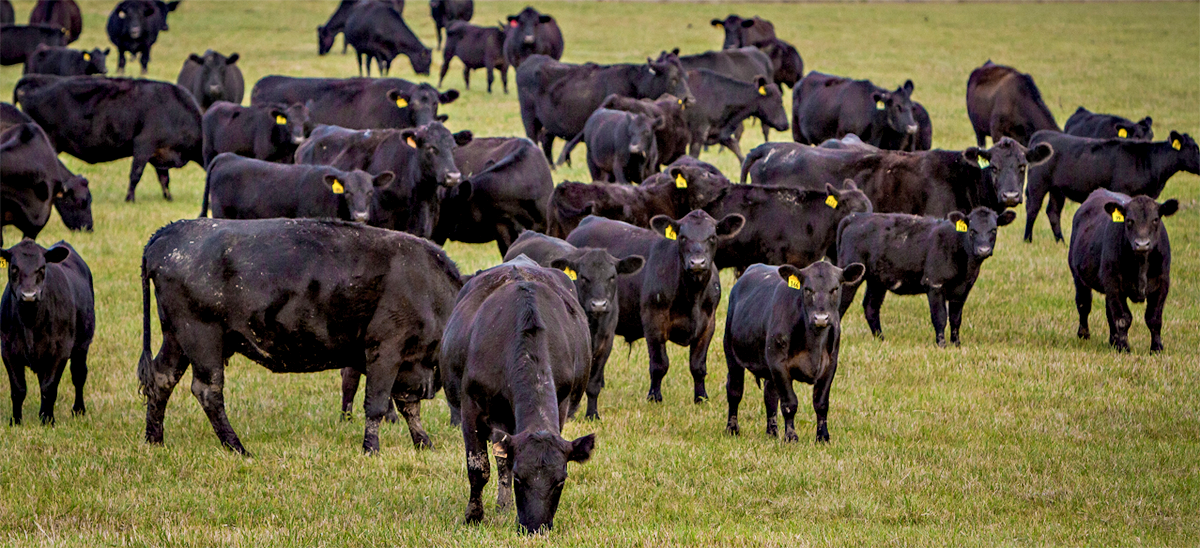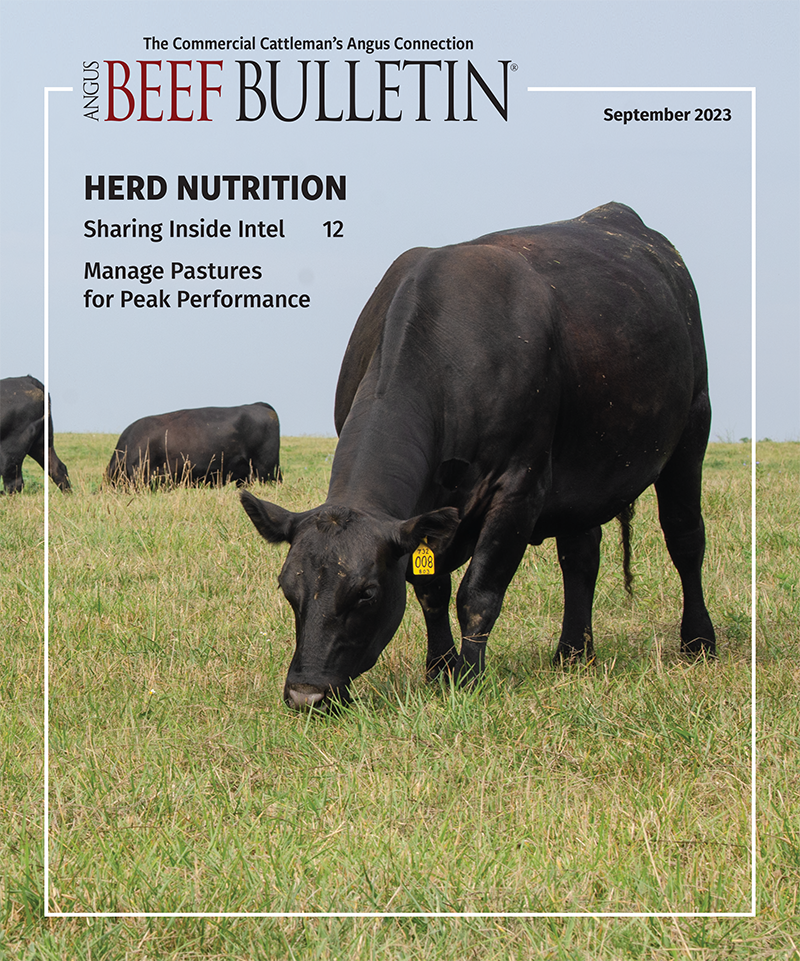
A group of Angus cows and their calves graze at Thompson Research Farm. [Photo courtesy Kyle Spradley.]
Study Validates Genomic Profile to Select Commercial Replacements
Study shows genomic prediction tool can help select best-in-class commercial cattle for superior breeding characteristics.
Ranches across the Show-Me State manage approximately 2 million cows, a significant number of which are Angus. In a new study, University of Missouri (MU) researcher Jared Decker and Thompson Research Farm personnel tested a group of commercial Angus cows using a genomic prediction tool called Zoetis GeneMax® AdvantageTM to investigate the ability of the test to predict their calves’ performance and profitability.
GeneMax Advantage was created through a collaboration between Angus Genetics Inc. (AGI), Certified Angus Beef (CAB) and Zoetis. It is intended for use in commercial females whose genetics are 75% or greater black Angus, such as an Angus-sired daughter of a halfblood Angus cow. The DNA profile delivers three economic index scores:
- Cow Advantage — ranking females for the combined genetic merit for heifer pregnancy, calving ease maternal and direct (includes birth weight), direct and maternal weaning weight (milk), docility and foot soundness (claw and angle composite), as well as associated costs of production due to differences in mature cow size and milk production, while also accounting for variation in cull cow value.
- Feeder Advantage — ranking females for net returns from combined genetic merit transmitted to progeny for postweaning gain, carcass weight and grade (USDA Quality and Yield Grades as predicted by component traits), and costs of gain due to genetic differences in dry-matter intake and associated feed-to-gain.
- Total Advantage — predicting differences in net returns for combined genetic merit across economically relevant traits captured in the Cow and Feeder Advantage indexes. As such, this is the one most simple and comprehensive prediction of system-wide production efficiency upon which to primarily base selection and breeding decisions.
While testing a sample of commercial Angus females and their offspring at MU’s Thompson Research Farm, Decker found significant relationships between the cows’ genetic merit based on the genomic profile and the performance of their calves. For the study, researchers focused on specific traits, such as weaning and carcass weight, marbling, fat and ribeye area.
“In prioritizing the use of this technology, Thompson Research Farm recently harvested a set of 35 steers, 70% of which graded Prime,” says Decker, Wurdack chair in animal genetics in the College of Agriculture, Food and Natural Resources. “Compared to the industry, which grades Prime at a rate of 6%, this is really excellent.”
Decker says this success stems from the technology that makes genomic predictions possible. In practice, DNA testing allows cattlemen to select better cows and refine the herd with good genetics on top of good management.
“It’s a goal of mine to help producers innovate in ways that get them closer to harnessing a competitive advantage in this market,” Decker says. “I want to help them adopt new technologies like DNA testing and genomic prediction. For a while now, we’ve had historical data on the performance of calves in terms of growth and carcass performance. So, a key goal of this study was to demonstrate to farmers, ranchers, extension professionals, veterinarians and academics that this technology does, in fact, work. There is a significant relationship between calf performance and the cow’s genetic merit.”
Although genomic prediction has a legacy of success in seedstock cattle — purebred animals with documented pedigrees — this study shows it can work in a sample of commercial cattle, Decker says.
“Genomic prediction tools allow farmers to go from not knowing the pedigree or any of the animal’s performance data to taking a DNA sample and receiving a very accurate prediction as to the heifer’s genetic merit,” says Decker, explaining that this technology opens doors for commercial producers to be more aggressive in selecting the right females to go back into the herd. “This gives farmers a chance to make informed decisions that enhance sustainable profitability.”
The genomic prediction technology provides operations large and small the means to document superior genetic merit of a calf crop, Decker says. The results can help producers make informed decisions on retaining ownership of cattle through the feedlot or assist in marketing calves to their full value.
“Farmers and ranchers really value this lifestyle; they value the family tradition,” Decker says. “That family tradition gives them the grit and the fortitude to deal with really challenging circumstances like drought or low prices or whatever the present big challenge is. So, helping them think strategically about how to create the best calf crop is something that will serve them and keep those family farms profitable.”
“Evaluation of Zoetis GeneMax Advantage genomic predictions in commercial Bos taurus Angus cattle” was published in Livestock Science. Co-authors include Brian C. Arisman, Troy N. Rowan, Jordan M. Thomas, Harly J. Durbin, William R. Lamberson and David J. Patterson.
Editor’s note: Courtney Perrett is strategic communication specialist and editorial bureau chief for the MU News Bureau, which provided this article.



